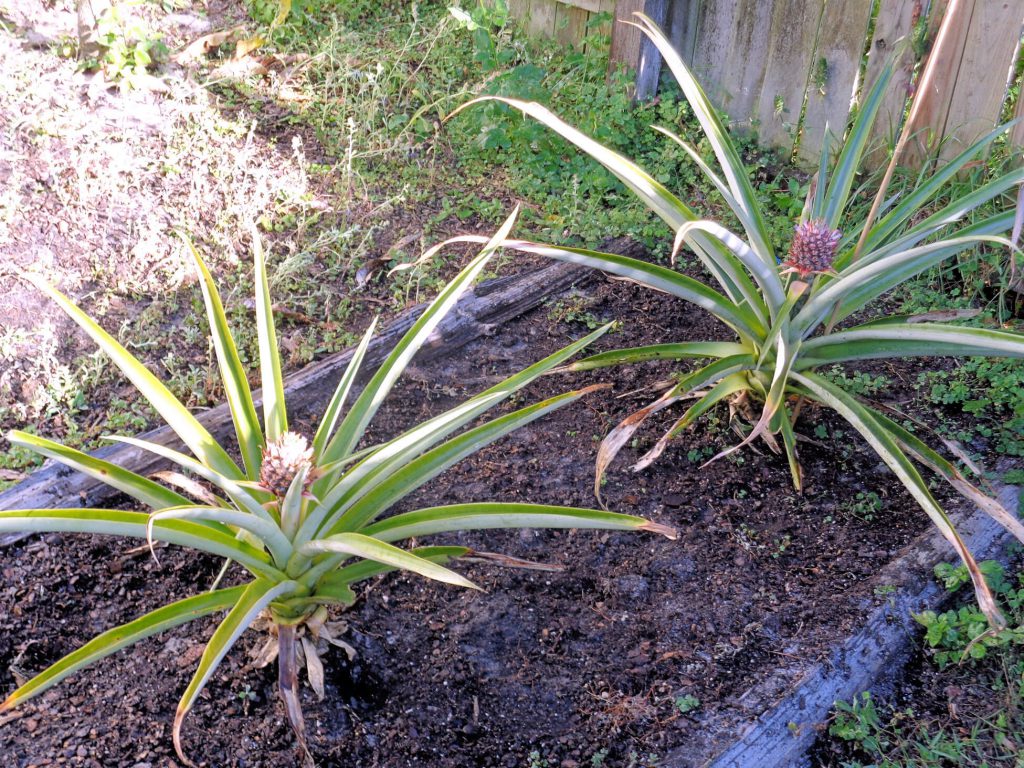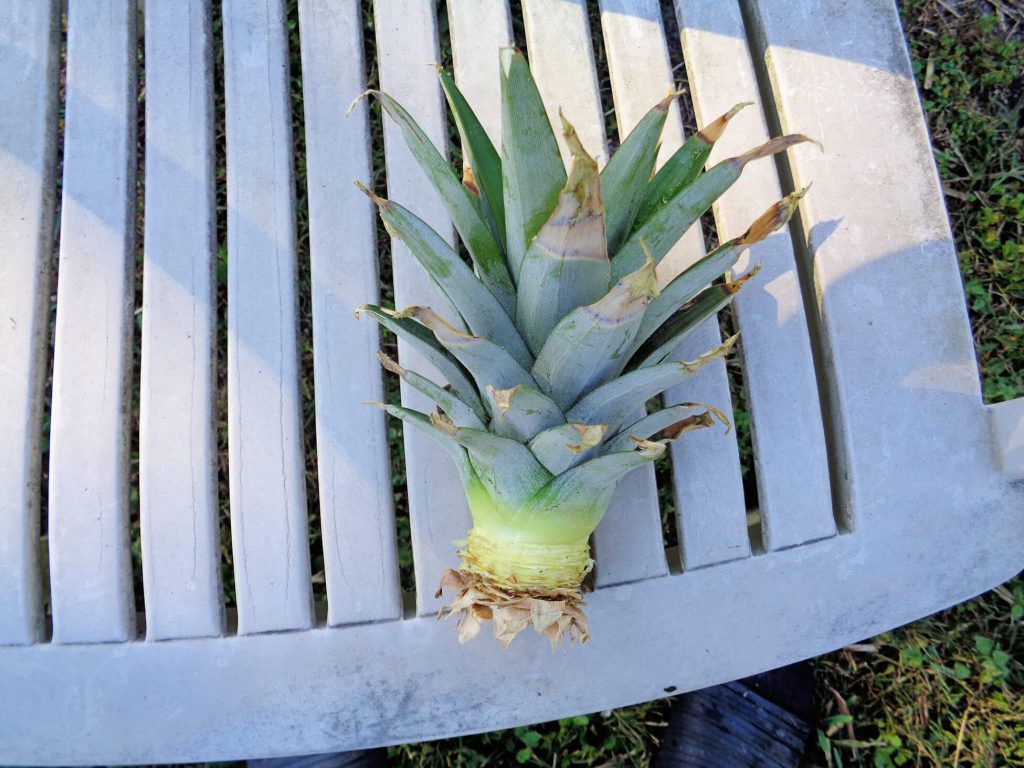By Ralph E. Mitchell
 You would think from their image that pineapples originated in Hawaii. The pineapple, which is a type of bromeliad like Spanish moss, actually originated in the tropical Americas and the Caribbean. Explorers moved the pineapple around the tropical parts of the world and export from the West Indies developed through the 19th Century. In 1860, pineapples were first introduced into Florida. A recent article on this introduction in The Sun reminded me of the fact that there was even a pineapple industry for a time in early days of our very own Punta Gorda. This historically significant, backyard crop is easy to grow! Mine are setting flowers right now, so I thought it timely to share some information on this interesting fruit.
You would think from their image that pineapples originated in Hawaii. The pineapple, which is a type of bromeliad like Spanish moss, actually originated in the tropical Americas and the Caribbean. Explorers moved the pineapple around the tropical parts of the world and export from the West Indies developed through the 19th Century. In 1860, pineapples were first introduced into Florida. A recent article on this introduction in The Sun reminded me of the fact that there was even a pineapple industry for a time in early days of our very own Punta Gorda. This historically significant, backyard crop is easy to grow! Mine are setting flowers right now, so I thought it timely to share some information on this interesting fruit.
Even if they never produced any fruit at all, pineapple plants are attractive subjects for the landscape all by themselves. A whorl of sword-like leaves form the actual pineapple plant which may grow up to six feet wide. Once the pineapple plant produces about seventy to eighty leaves, a flower is produced. Cool weather and short days naturally help induce a pineapple to flower. The flower is another very ornamental feature manifest as a compressed reddish oval of flower buds emerging from the center of the plant. The individual flower is white with a violet-colored tip that opens up, several at a time, as the pineapple fruit forms. The fruit develops as a result of a fusion of smaller individual fruitlets into one big fruit. The green peel eventually ripens to a golden color accompanied by an attractive scent. With a fruit weight of up to five pounds, staking may be required to keep it from tipping over. A pineapple may take anywhere from eighteen to thirty-six months from planting to harvest. On average, you can expect a pineapple from flower to ripe fruit in about seven months. Wait to harvest until one-third to two-thirds of the pineapple peel has turned from green to yellow for best sweetness. Then, allow the fruit to completely ripen at room temperature indoors. Once fully ripe, you can store the fruit in the refrigerator for a week.
There are many varieties of pineapple, but some may be difficult to find. One called ‘Smooth Cayenne’ is the most commonly available pineapple worldwide. This cultivar has high sugar content with yellow flesh. The leaves have some spines on three-foot-long foliage. Another variety, not as available as ‘Smooth Cayenne’, is ‘Red Spanish’ which is noted for a square-shaped fruit and spiny leaves. A very different type to try is ‘Sugarloaf’. The leaves of ‘Sugarloaf’ are completely smooth, and the flesh is white in color.
 We can easily grow pineapples here in Charlotte County! To start pineapples, you first need either a crown from the fruit, a slip, hapa, or sucker. The crown from the fruit is of course the pineapple top that you would ordinarily cut off and throw away. A slip is a sprout that comes from below the fruit on the fruit stalk. Hapas are like slips, but develop below the base of the fruit. Suckers form at the base of the leaves of the old mother plant. Don’t be too quick to remove slips, hapas, or suckers from the mother plant. The bigger and more developed that all of these propagation materials are, the quicker they will develop into a fruiting plant. Whichever plantlet type you use, detach it from the mother plant and let it dry in a shaded location for about two days. Pot these plantlets up in clean potting medium to start new plants. Set rooted plants out in full sun locations situated in planting beds enriched with compost about thirty-six inches apart to help develop large and vigorous plants. The larger the pineapple plant at flowering, the larger the resulting fruit. Pineapples are also well suited to small space gardening and can be easily grown in a seven-gallon container.
We can easily grow pineapples here in Charlotte County! To start pineapples, you first need either a crown from the fruit, a slip, hapa, or sucker. The crown from the fruit is of course the pineapple top that you would ordinarily cut off and throw away. A slip is a sprout that comes from below the fruit on the fruit stalk. Hapas are like slips, but develop below the base of the fruit. Suckers form at the base of the leaves of the old mother plant. Don’t be too quick to remove slips, hapas, or suckers from the mother plant. The bigger and more developed that all of these propagation materials are, the quicker they will develop into a fruiting plant. Whichever plantlet type you use, detach it from the mother plant and let it dry in a shaded location for about two days. Pot these plantlets up in clean potting medium to start new plants. Set rooted plants out in full sun locations situated in planting beds enriched with compost about thirty-six inches apart to help develop large and vigorous plants. The larger the pineapple plant at flowering, the larger the resulting fruit. Pineapples are also well suited to small space gardening and can be easily grown in a seven-gallon container.
Pineapples can produce a second fruit or ratoon crop if a sucker that emerges from below the fruit is allowed to grow. Make sure to remove all of the suckers and hapas except one which is then allowed to
develop and produce a second fruit. A granular fertilizer such as 10-10-10 or its equivalent every eight weeks will help plants grow well. Also consider using a liquid fertilizer as per label directions. There are also foliar nutrient mixes with micronutrients that will benefit pineapple plants. Applying an organic mulch will also help maintain moisture and suppress weeds. So, don’t through away that pineapple top! While there is certainly an investment in time, growing your own fresh pineapples is a worthwhile effort! For more information on growing all types of backyard fruit, please visit https://www.facebook.com/CharlotteMGLifeline/. Ralph E. Mitchell is the Director/Horticulture Agent for the UF/IFAS Charlotte County Extension Service. He can be reached at 941-764-4344 or ralph.mitchell@charlottecountyfl.gov.
Resource:
Crane, J.H. (2019) Pineapple Growing in the Florida Home Landscape. UF/IFAS Extension Service.
 1
1
